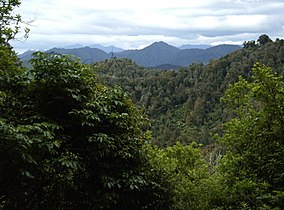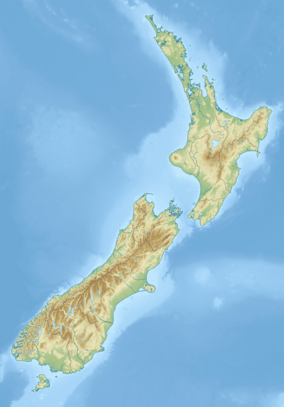Te Urewera National Park
| Te Urewera National Park | |
|---|---|
 | |
| Location | Hawke's Bay |
| Nearest city | Gisborne, New Zealand |
| Coordinates | 38°45′0″S 177°9′0″E / 38.75000°S 177.15000°E |
| Area | 2,127 km2 (821 sq mi) |
| Established | 1954 |
| Disestablished | 2014 |
| Governing body | Department of Conservation |
| Website | DOC page |
Te Urewera National Park was a national park near the east coast of New Zealand's North Island, established as such in 1954 and disestablished in 2014, when it was replaced by a new legal entity and protected area named Te Urewera.[1] The park covered an area of approximately 2,127 km2 and was located in the north of the Hawke's Bay region of the North Island. It was the largest of four national parks in the North Island and the most isolated rainforest in the region.[2]
History
[edit]Owing to its geographical isolation, the region was one of the last to be claimed by the British during colonisation in the 19th century.[3]
On 28 July 1954, the catchment areas of Lake Waikaremoana and Lake Waikareiti and other Crown reserves were gazetted as a national park, and by 1957 proposals were well under way to add the rest of the Crown land in Te Urewera north of Ruatāhuna. This proposal was formalised in November 1957, when an additional 1,350 km2 were added. Further additions were made in 1962, 1975, and 1979, with smaller acquisitions of land and boundary alterations in the intervening period. The lake bed and Māori enclaves were not included in the gazetting of the park. The Crown had leased the lake bed, which was managed by the Department of Conservation.
In March 2013, the Tūhoe people signed a deed of settlement, settling the tribe's claims under the Waitangi Tribunal. Under the deal, the Tūhoe were to receive NZ$170 million and also be given more control over Te Urewera.[3] It ceased to be a national park under the Te Urewera Act 2014, becoming Te Urewera,[1][4] the first natural resource in the world to be awarded the same legal rights as a person.[5][6]
Name
[edit]Te Urewera is the traditional home of the Tūhoe people. The name means "burnt penis" in the Māori language and reflects a local legend.[7][8]
See also
[edit]References
[edit]- ^ a b Ruru, Jacinta (October 2014). "Tūhoe-Crown settlement – Te Urewera Act 2014". Māori Law Review: 16–21. Retrieved 13 December 2015.
- ^ "Te Urewera: New Zealand's 'living' rainforest". No. BBC Travel. BBC. 30 September 2021.
- ^ a b "Govt and Tuhoe sign $170m settlement". Newshub. 22 March 2013. Archived from the original on 24 March 2016.
- ^ Cheng, Derek (25 July 2014). "Tuhoe takes lead in homeland's future". The New Zealand Herald. Retrieved 25 July 2014.
- ^ Gibson, Jacqui (9 June 2020). "The Māori tribe protecting New Zealand's sacred rainforest". BBC Travel. Retrieved 29 September 2021.
- ^ BBC's The Travel Show (29 September 2021). "Te Urewera: New Zealand's 'living' rainforest". BBC Travel. Retrieved 29 September 2021.
- ^ Lind, Clive (31 January 2009). "Deep into the land of the mist". Stuff. Archived from the original on 15 March 2018.
- ^ "New Zealand Gazetteer". Toitū Te Whenua. Retrieved 16 October 2024.
The name recalls Murakareke, a rangatira who had reached a great age. While fleeing after a terrible defeat, he had a disagreement with his sons Tamakaimoana and Tuhoepotiki near the Whakatane River, suffered a fit, and fell onto their cooking fire. His penis was badly burnt and, on some accounts, he died from his burns.'
External links
[edit]- Te Urewera, Department of Conservation
- Te Urewera Act 2014
- Journeys in National Parks: Te Urewera, 1987 documentary at NZ On Screen
- Tourism information page
- IUCN Category II
- Te Urewera (protected area)
- Protected areas established in 1954
- Protected areas disestablished in 2014
- Nature reserves in New Zealand
- Wildlife sanctuaries of New Zealand
- Protected areas of Hawke's Bay
- Former national parks
- Whakatāne District
- Ōpōtiki District
- Gisborne District
- Wairoa District
- National parks of New Zealand

